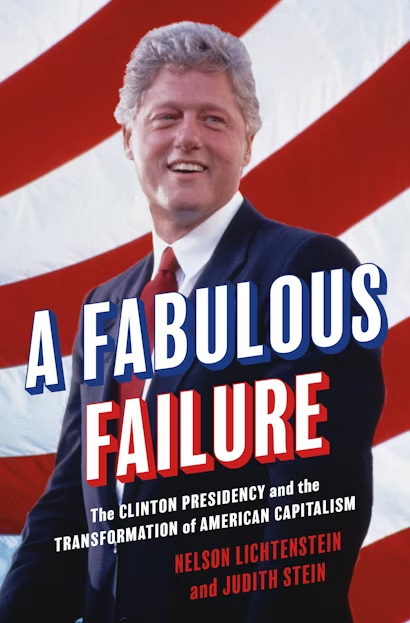Bill Clinton and Joe Biden have a lot in common. Both are ambitious, lifelong politicians, white men of the same generation, who came to preside over Democratic presidential administrations confronted with an economic crisis that had deep-seated and intractable roots. Neither commanded a large Democratic majority in Congress and both had to trim their legislative sails when they faced resistance and division, sometimes within their own party.
And yet their fates are entirely different three years into the respective administration of each president. By 1995 Bill Clinton was fighting to remain “relevant” to the politics of his day. His first budget was an austere economic compromise that skimped on stimulus funding, while his ambitious effort to reform and expand health care insurance and provision had tumbled into history’s dustbin. Passage of the North American Free Trade Agreement in 1993 created bitter rifts among Democrats, setting the stage for a massive Republican takeover in Congress. Many would soon label Clinton a “Democratic Eisenhower,” leading a party whose electoral success was predicated upon a wholesale accommodation to the ideologies of its opponents.
Joe Biden’s world seems entirely different. His administration has pushed through Congress trillions of dollars in new spending designed to rebuild infrastructure and reindustrialize key economic sectors. The Republicans underperformed during the midterm elections, and although Biden has not been a hugely popular President, he presides for the most part over a remarkably unified party.
The contrast between the fates of these two presidents is striking. However, understanding the reasons and mechanisms behind their distinct paths is even more instructive. I have labeled my reconsideration of Bill Clinton’s Presidency “A Fabulous Failure” because I don’t think one can comfortably label that president and many of his close collaborators neoliberal ideologues on the day they marched into the White House 30 years ago.
Their ambitions were more progressive. In 1992 Bill Clinton campaigned for the presidency on a program holding that the management and reform of American capitalism could hardly be left to the market alone. It was a task that required a plan and a purpose. One could glimpse that expansive promise when on December 14 and 15, 1992, the Clinton transition team assembled more than 300 of the nation’s leading economists, executives, politicians, and policy entrepreneurs in Little Rock for an “economic summit.” Almost all agreed with campaign strategist James Carville’s now-famous catchphrase, “The Economy, Stupid.” It was time for the government to offer a forceful set of initiatives designed to increase the productivity of capital and labor, transform key industry sectors, and enhance the quality of American life.
“We clearly face structural problems that today threaten our ability to harness the energies of all of our people,” said the President-elect. On display was an adventuresome range of ideas, reflecting a renewed set of Democratic ambitions after nearly two decades of progressive frustration, defeat, and economic dislocation spanning the tenures of every president since Richard Nixon. There were plenty of corporate chieftains in attendance, not so much to balance the academics and think-tank liberals with a more conservative outlook, but to demonstrate that the underperformance of the American economy was so debilitating that they too had a stake in efforts to rehabilitate industries and enterprises, especially those threatened by new competitors abroad and burdened by growing health care expenses at home. The end of the Cold War had hardly generated a sense of triumphalism. Massachusetts Democratic Paul Tsongas captured much of this angst during his brief campaign for the Democratic presidential nomination that year. “The Cold War is Over,” he asserted, “Japan and Germany Won.”
Clinton had been governor of a poor, Southern, rural state, spending the bulk of his time seeking to attract industry, raise wages, and increase worker skills and education. Clinton visited Germany, Japan, Italy, and South Korea looking for models and investments. He was therefore amenable to an “industrial policy” that deployed governmental power to advance economic development. Clinton’s appointment of several of the most high-profile advocates of such a program—Robert Reich at the Department of Labor, Laura Tyson as chair of the Council of Economic Advisors, Jeffery Garten in the US Trade Office, and Ira Magaziner in charge of health reform—was an indication of the degree to which this view enjoyed purchase within his new administration.
Today this aspect of the Clinton presidency has been largely discounted. Bill Clinton was the first Democratic President since FDR to win two consecutive terms, but that accomplishment seems merely a product of his accommodation to an ideology that privileged trade liberalization, financial deregulation, privatization of government services, and the growth of class inequalities. Clinton’s 1996 declaration, “The era of big government is over,” seemingly ratified Reaganite conservatism.
During the years after 1994, the drift toward such neoliberalism was much encouraged by the widespread view that the United States was indeed entering a “new economy” propelled by technologically-driven productivity gains, global trade, and financial innovation that simultaneously reduced unemployment and interest rates, elevated the stock market, and made international trade a win-win proposition. This “new economy” idea captivated everyone from Newt Gingrich and Alan Greenspan on the libertarian right to Robert Reich and Lester Thurow on the industrial policy left.
The idea would expire even before the Great Recession. But in the meantime, it constituted a powerful illusion. In December 1992, when Clinton kick-started the Little Rock economic summit, a sense of crisis pervaded the discussion about reshaping the American version of world capitalism. Fast forward to April 2000, Clinton convened a “White House Conference on the New Economy.” There, a techno-triumphalism animated the conclave, with Clinton announcing “We meet in the midst of the longest economic expansion of our history and an economic transformation as profound as that that led us into the industrial revolution.” At Little Rock, the leadoff speaker had been Robert Solow, the Keynesian theorist of economic growth; at the 2000 White House conference it was Abby Joseph Cohen, the famed, hyper-bullish stock market analyst from Goldman Sachs. Bill Clinton told that White House conference, “I believe the computer and the internet give us a chance to move more people out of poverty more quickly than at any time in all of human history.”
That was an illusion, but an even greater failure may well have arisen from the Clinton Administration’s actual achievements: creating a federal budget surplus, downsizing the government workforce, enacting an ambitious crime control law, passing the North American Free Trade Agreement, constructing a pathway for China to join the World Trade Organization, and deregulating both Wall Street finance and America’s vast telecommunications infrastructure. Wall Street boomed and unemployment dropped, but in the end, none of these reforms moved the nation toward the economic stability, social equality, or global democratic resurgence. Trade with China, the Clintonites had prophesied, would undoubtedly create the conditions for a free press, entrepreneurial freedom, and the autonomy, individual and organizational, necessary to sustain a robust civil society in that ancient nation. They were convinced that democratic effervesce was sure to accompany all those new cell phones, stock markets, and supermarkets.
Moreover, virtually every legislative victory scored by the Clinton Administration, especially in the years after 1994, faced significant opposition from within his own party. On many Clinton initiatives, especially those involving trade and financial deregulation, the White House relied on Republican votes, while a large fraction of the Democrats, sometimes even a majority, stood in opposition to their own president. Clinton was a dreadful party leader.
Clinton’s economic vision no longer commands the hegemonic assent it seemed to enjoy a quarter century ago. Few think that capital mobility, new technology, or greater international trade are creating the frictionless, fabulous world so many projected in the immediate post-Cold War years. Meanwhile, the industrial policy initiatives explored in the early Clinton era no longer seem quite so freckless. The trillion-dollar appropriations of the last three years, sometimes enacted with bipartisan support, constitute what Biden has labeled “an American industrial strategy,” designed to keep pandemic-threatened enterprises afloat, sustain working-class incomes, rebuild key industries, strengthen infrastructure, fund health insurance, and fight climate change. This agenda mirrors that of Magaziner, Reich, and Tyson 30 years before. While a new consensus is yet to form, the failures of the Clinton presidency can now be examined in a new light, one in which a neoliberal world no longer seems the wave of the future.
Nelson Lichtenstein is Research Professor at the University of California, Santa Barbara. He is the author, with Judith Stein, of A Fabulous Failure: The Clinton Presidency and the Transformation of American Capitalism.

